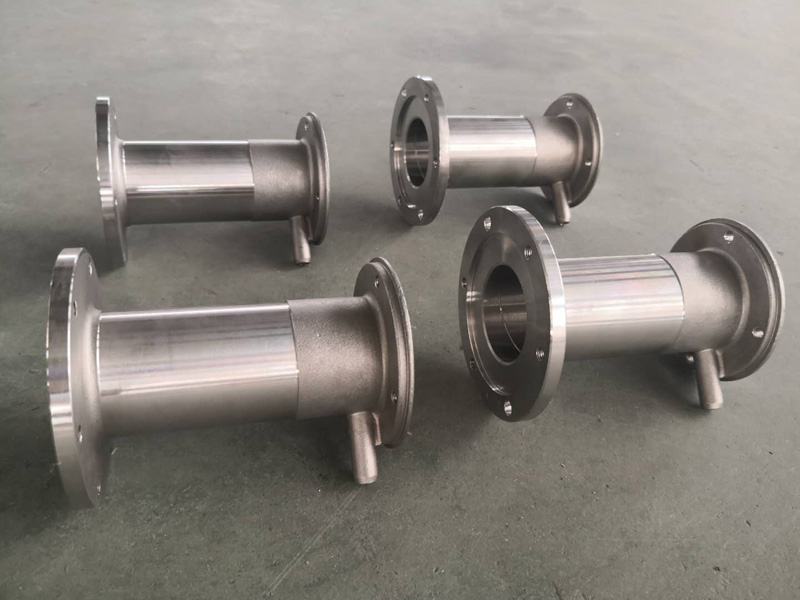Carbon steel precision castings are not typically forged as a separate process. Precision castings and forgings are two distinct manufacturing methods with different techniques and characteristics.
In some cases, a carbon steel precision casting may undergo additional shaping or forming steps after the casting process to refine or modify its shape. This may involve using forging techniques as a secondary operation. The primary purpose of such secondary forging steps is usually to enhance the mechanical properties or achieve specific dimensional requirements that may be difficult to achieve through casting alone.
The specific steps involved in forging a carbon steel precision casting would depend on the desired modifications or refinements. For instance, if dimensional accuracy needs to be improved or certain features need to be reshaped, the casting may be reheated and subjected to forging processes such as closed-die forging or open-die forging. These processes involve applying compressive forces to the heated casting to deform it and achieve the desired shape.
It is important to note that combining casting and forging in this manner requires careful consideration of the material properties and the feasibility of the desired modifications. Not all precision castings are suitable for secondary forging, as the casting process may introduce certain features or characteristics that could affect the integrity or performance of the part when subjected to forging.
Additionally, it is worth mentioning that there are specific limitations to the size and complexity of parts that can be forged. Forging is typically more suited for simpler shapes and smaller-sized components. Large-sized carbon steel precision castings would require specialized equipment, extensive heat treatment, and significant forging forces, which may not be feasible or cost-effective.
In conclusion, while carbon steel precision castings are not typically forged as a separate process, it is possible to incorporate secondary forging operations to modify or refine the shape of the casting. However, the feasibility and effectiveness of such secondary forging would depend on the specific requirements, material properties, and the size and complexity of the casting.
During the casting process of large carbon steel precision castings, issues such as sand inclusions and porosity can often occur. This article summarizes several solutions to address these problems:
- Controlling Sand Inclusions: Sand inclusions can be controlled by implementing various measures, such as applying coatings or paints to the mold surface, increasing the strength of the mold, ensuring strict molding practices, and utilizing flask shaking or ramming techniques. These methods help prevent loose sand particles from entering the mold cavity and causing sand inclusions in the final casting.
- Managing Porosity: To control porosity in carbon steel precision castings, several steps can be taken. Firstly, it is essential to thoroughly deoxidize the molten steel before pouring. This helps reduce the oxygen content, minimizing the formation of gas bubbles. Additionally, controlling the moisture content of the molding material is crucial to prevent steam or gas generation during the casting process. Proper venting of the mold cavity and core is essential to allow gases to escape smoothly. Furthermore, controlling the pouring temperature, speed, and duration of the casting process, as well as implementing appropriate gating and risering systems, can help prevent the formation of porosity.
By following these solutions and implementing proper process controls, the formation of sand inclusions and porosity can be effectively minimized in large carbon steel precision castings.
Overview of Large Carbon Steel Precision Castings
Large carbon steel precision castings are typically cast using the investment casting process, also known as precision casting or lost-wax casting. The steps involved in casting large carbon steel precision castings are as follows:
- Pattern Creation: The process begins with the creation of a pattern, which is an exact replica of the final desired part. The pattern can be made from various materials such as wax, plastic, or even metal. It is essential to ensure that the pattern is dimensionally accurate and of high quality.
- Assembly: Multiple patterns may be combined to create a cluster, or “tree,” of patterns. These patterns are attached to a central sprue, which forms the main channel for molten metal flow.
- Shell Molding: The patterns or pattern clusters are then coated with a ceramic slurry. After coating, they are covered with a fine refractory material, such as sand or stucco, to create a ceramic shell. This process is repeated multiple times, building up layers to form a strong and precise mold.
- Dewaxing: Once the ceramic shell is fully dried and hardened, the entire assembly is heated to melt and remove the wax or plastic patterns. This step is known as dewaxing, and it creates a cavity in the ceramic shell that matches the shape of the desired part.
- Preheating: After dewaxing, the ceramic shell is preheated to a specific temperature to remove any remaining moisture and ensure the mold is ready to withstand the high temperature of the molten metal.
- Pouring: The preheated ceramic shell is placed in a flask and securely positioned. Molten carbon steel, often heated in an induction furnace, is poured into the ceramic shell through the sprue. The molten metal fills the cavity, taking the shape of the desired part.
- Solidification: Once the mold is filled, the molten metal is allowed to cool and solidify. The solidification process ensures that the metal takes on the desired shape and properties.
- Cooling and Removal: After solidification, the entire mold is allowed to cool. Once the metal has cooled sufficiently, the ceramic shell is broken or removed, revealing the solidified carbon steel casting.
- Finishing: The castings are then subjected to various finishing processes, including removal of excess material, grinding, polishing, heat treatment, and machining. These processes help achieve the final dimensions, surface finish, and desired mechanical properties.
By following these steps, large carbon steel precision castings can be produced with intricate shapes, tight tolerances, and excellent surface finishes, meeting the specific requirements of various industries.
Large carbon steel precision castings are an essential component in various industries, including aerospace, automotive, and construction. These castings are made using the investment casting process, which involves creating a wax pattern of the part, coating it in ceramic and firing it to create a mold, and then pouring molten steel into the mold to create the final product.
Carbon steel is a popular material for precision castings due to its strength, durability, and affordability. It is also highly versatile, with a wide range of carbon content options that allow for customized mechanical properties. Large carbon steel precision castings can be found in a variety of applications, from engine blocks to industrial machinery components. These castings can be produced in a range of sizes and weights, up to 80 lbs.

Definition of Large Carbon Steel Precision Castings
Large carbon steel precision castings refer to the process of creating complex and intricate parts made of carbon steel through the investment casting method. This process involves creating a wax pattern of the part, coating it with ceramic, and then pouring molten carbon steel into the mold. The final product is a near-net shape part that requires minimal machining or finishing.
